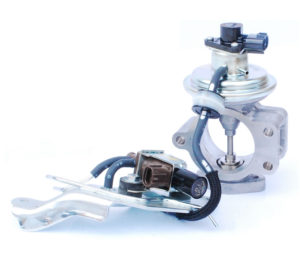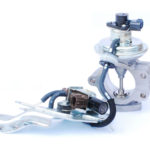This article taken from Toyota GB explains what an EGR valve is, what it does and what happens when it fails. The common signs of failure include engine performance issues like decreased power and acceleration, rough idle, and the engine management light coming on forcing the car to drive in limp mode. This article explains everything you need to know about complete EGR valves.
What is an exhaust gas recirculation (EGR) valve?
The EGR valve is fitted before the exhaust system, it allows some of the gases produced during the combustion process to be re-burnt within the combustion chamber for a second and more effective time.
This occurs when the correct engine operating conditions are met and in turn, serves to reduce harmful emissions.
What does an EGR valve do?
The process of recirculating precise quantities of exhaust gases back into the combustion chamber has a number of advantages.
In petrol engines, it helps to lower combustion temperatures and reduces the chance of spontaneous combustion, also known as ‘knock’. This in turn, allows the engine control unit (ECU) to dilute the air & fuel mixture and reduce petrol consumption.
In diesel engines, the role of the EGR valve is even more important. Routing exhaust gases back into the combustion chamber lowers combustion temperatures. The primary benefit in this instance is the reduced formation of harmful particulates.
In addition, the reappearance of spent exhaust gases within the combustion chamber enables the engine to neutralise these particulates through secondary burning.
Does the EGR valve relate to the function of the DPF?
Yes, but indirectly. The neutralising of nitrous oxide soot within the combustion chamber reduces the quantity of this material heading into the diesel particulate filter (DPF) installed further down the exhaust system.
This increases the time period between regeneration procedures and the service life of the DPF itself.
Why might an EGR valve fail?
Its location within the direct path of flowing exhaust gases means that soot can accumulate around the EGR valve and block its free movement. It is possible to mitigate this by ensuring the vehicle is regularly driven at sustained speeds above 40mph. Constant use of any vehicle in low-speed, urban environments with frequent stops will accelerate the amount of soot collecting around the EGR valve.
How can I tell if the EGR valve in my car is failing?
A failing EGR valve will affect the performance and economy of your engine, though it is likely that the ECU will notice the issue and alert the driver through a dashboard warning light before any physical symptoms are experienced. These symptoms may include rough idling, hesitance in acceleration and a loss in fuel economy.
What to do if the engine management light comes on?
Take vehicle to your mechanic to be checked as soon as possible. They will initially carry out a diagnostic check. If the fault code displayed relates to exhaust gas recirculation, the likelihood is that the valve will need to be either cleaned or replaced. Cleaning an EGR valve is much cheaper than replacement, so it is prudent to react immediately to all warning lights.
This information has been sourced by The Official Blog of Toyota GB from their own article Understanding exhaust gas recirculation valves.
